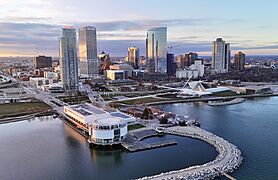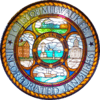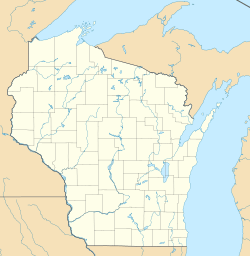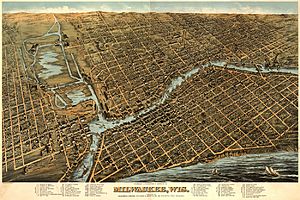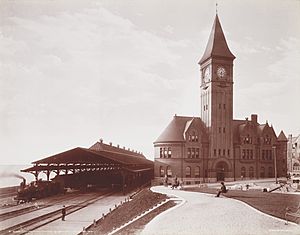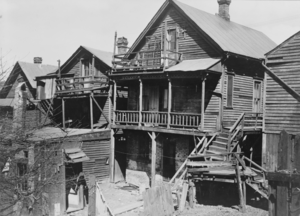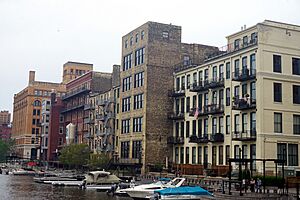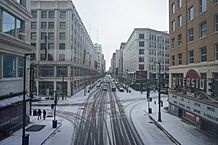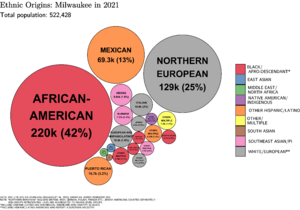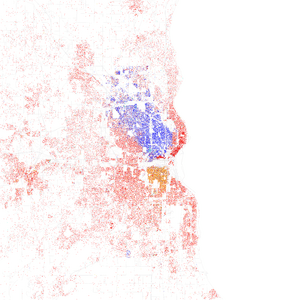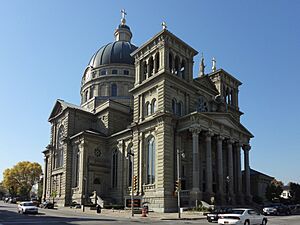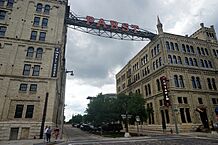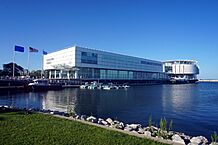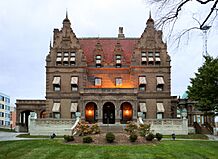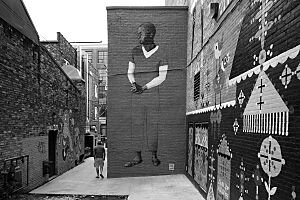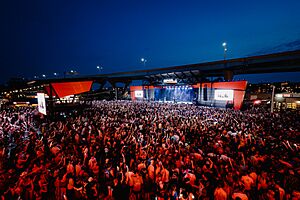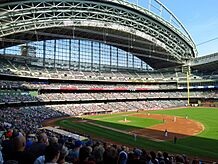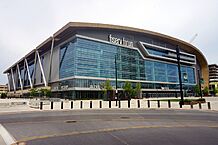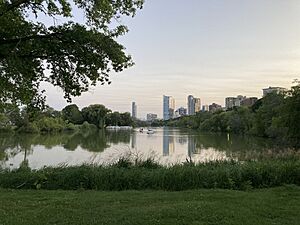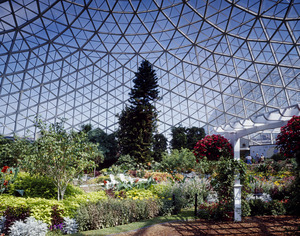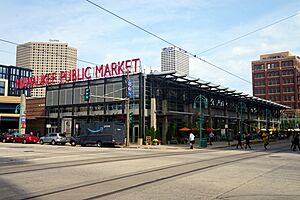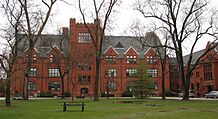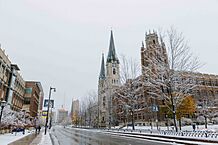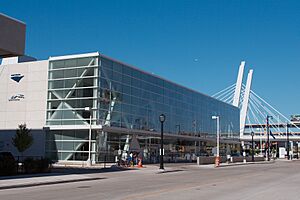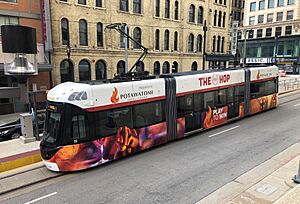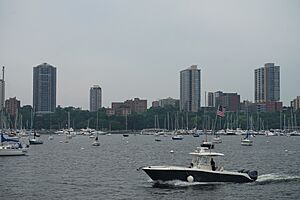Milwaukee facts for kids
Quick facts for kids
Milwaukee
|
|||||
|---|---|---|---|---|---|
|
Downtown Milwaukee
Milwaukee Riverwalk
|
|||||
|
|||||
| Nickname(s):
Cream City, Brew City, Beer Capital of the World, Miltown, The Mil, MKE, The City of Festivals, The German Athens of America, The 414
|
|||||
| Country | United States | ||||
| State | Wisconsin | ||||
| Counties | Milwaukee, Washington, Waukesha | ||||
| Incorporated | January 31, 1846 | ||||
| Founded by | Solomon Juneau, Byron Kilbourn, and George H. Walker | ||||
| Named for | Potawatomi for "gathering place by the water" | ||||
| Government | |||||
| • Type | Strong mayor-council | ||||
| • Body | Milwaukee Common Council | ||||
| Area | |||||
| • City | 96.81 sq mi (250.75 km2) | ||||
| • Land | 96.18 sq mi (249.12 km2) | ||||
| • Water | 0.63 sq mi (1.63 km2) | ||||
| Elevation | 617 ft (188 m) | ||||
| Population
(2020)
|
|||||
| • City | 577,222 | ||||
| • Estimate
(2024)
|
563,531 |
||||
| • Rank | 85th in North America 31st in the United States 1st in Wisconsin |
||||
| • Density | 5,962.42/sq mi (2,301.98/km2) | ||||
| • Urban | 1,306,795 (US: 38th) | ||||
| • Urban density | 2,818.3/sq mi (1,088.2/km2) | ||||
| • Metro | 1,574,731 (US: 40th) | ||||
| • CSA | 2,049,805 (US: 33rd) | ||||
| Demonym(s) | Milwaukeean | ||||
| GDP | |||||
| • Metro | $120.563 billion (2022) | ||||
| Time zone | UTC−6 (CST) | ||||
| • Summer (DST) | UTC−5 (CDT) | ||||
| ZIP Codes |
53172, 532XX
|
||||
| Area code(s) | 414 | ||||
| FIPS code | 55-53000 | ||||
| GNIS feature ID | 1577901 | ||||
Milwaukee is the largest city in the U.S. state of Wisconsin. It sits on the western shore of Lake Michigan. Milwaukee is the 31st most populated city in the United States. In 2020, about 577,222 people lived there. The larger Milwaukee area, including nearby towns, has over 1.57 million residents. Milwaukee is also the main city of Milwaukee County.
The city was started in the early 1800s and became an official city in 1846. It grew quickly because it was a good port city. Many German immigrants came to Milwaukee, which shaped its history and culture. It became famous for its brewing industry. Milwaukee is a city with many different cultures and people. It is known for its strong industries and cultural places.
Milwaukee is home to big companies like Northwestern Mutual and Harley-Davidson. It also has famous cultural spots. These include the Harley-Davidson Museum, Milwaukee Art Museum, and Milwaukee Public Museum. The city hosts Summerfest, one of the world's largest music festivals. You can also find several colleges here, such as Marquette University and the University of Wisconsin–Milwaukee. Milwaukee has professional sports teams like the Milwaukee Brewers (baseball) and Milwaukee Bucks (basketball).
Contents
- History of Milwaukee
- Milwaukee's Geography
- Milwaukee's People
- Milwaukee's Economy
- Milwaukee's Culture
- Sports in Milwaukee
- Parks and Outdoor Fun
- City Government and How it Works
- Education in Milwaukee
- Media and News
- City Services and Transportation
- City Development
- Notable People
- Sister Cities
- See also
History of Milwaukee
What's in a Name?
The exact meaning of the name Milwaukee is a bit of a mystery. One idea is that it comes from an Ojibwe word meaning "good land." Other Native American languages, like Menominee and Potawatomi, have similar words. Another idea is that it comes from a Meskwaki word meaning "gathering place." The city itself says the name comes from a Potawatomi word for "council grounds."
Before 1844, people spelled Milwaukee in many ways. Some called it Milwaukie, especially those living east of the river. The Milwaukee Sentinel newspaper used Milwaukie until it changed to Milwaukee in 1844. The city of Milwaukie, Oregon still uses the older spelling.
Early Native American Life
For thousands of years, Native American groups lived along the rivers in the Milwaukee area. The first known tribes here were the Menominee, Meskwaki, Potawatomi, and Ojibwe. These groups were part of the Algonquian peoples. The Ho-Chunk (Winnebago) people, who spoke a Siouan language, also lived here. Many of these tribes moved to the Milwaukee area around the time Europeans first arrived.
In the late 1700s, Native Americans in Milwaukee were involved in major wars on the American continent. After the American Revolutionary War, they fought the United States in the Northwest Indian War. In 1833, the Native Americans in Milwaukee signed a treaty. They agreed to give up their lands in the area. In return, they received money and land west of the Mississippi River.
European Settlers Arrive
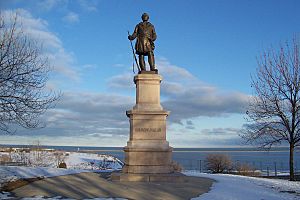
French missionaries and traders visited the Milwaukee area in the late 1600s and 1700s. Alexis Laframboise was the first European settler, setting up a trading post in 1785.
Milwaukee has three main "founding fathers": Solomon Juneau, Byron Kilbourn, and George H. Walker. Solomon Juneau arrived in 1818 and started a town called Juneautown. Byron Kilbourn started Kilbourntown west of the Milwaukee River. He made sure the roads in his town didn't line up with Juneautown's roads. This is why many bridges in Milwaukee today are angled. George H. Walker settled land south of the Milwaukee River, which became Walker's Point.
Many new settlers began arriving in 1835. By 1840, the three towns had grown, and so had their rivalries. This led to the Milwaukee Bridge War in 1845. After the war, on January 31, 1846, the towns joined together to form the City of Milwaukee. Solomon Juneau became the city's first mayor.
City Growth and New Arrivals
Milwaukee grew quickly as many immigrants, especially Germans, moved to Wisconsin in the 1840s and 1850s. By 1900, about 34% of Milwaukee's population was of German background. Milwaukee became known as the most German city in America. This was because so many Germans moved there and built strong communities.
Many German immigrants came looking for affordable farmland. After the Revolutions of 1848 in Europe, more Germans came to the U.S. to avoid problems in their home country. These people were called "Forty-Eighters". They helped create many clubs and societies in Milwaukee. Today, Milwaukee still celebrates its German culture with events like German Fest and Oktoberfest.
After the Civil War, other groups also came to Milwaukee. Many Polish immigrants arrived, looking for jobs. Milwaukee became home to one of the largest Polish-American communities. The South Side of Milwaukee is often linked with the Polish community. Places like St. Stanislaus Catholic Church and the Basilica of St. Josaphat were important centers for Polish life. Milwaukee has the fifth-largest Polish population in the U.S. The city also hosts Polish Fest every year.
Many other European immigrants came to Milwaukee, including people from Lithuania, Italy, Ireland, France, Russia, and Sweden. This included Jewish, Lutherans, and Catholics. By 1910, Milwaukee had one of the highest percentages of foreign-born residents in the United States. The city also has large Greek Orthodox, Croatian, and Serbian communities.
During this time, a small number of African Americans moved from the South to Milwaukee. They formed a community known as Bronzeville. As industries grew, more African Americans moved to the city, and their influence increased.
Milwaukee in the 1900s and Today
In the early 1900s, Milwaukee was known for electing mayors from the Socialist Party of America. These mayors, sometimes called "Sewer Socialists", focused on practical improvements for the city.
By the mid-1900s, more African Americans moved to Milwaukee's North side. The city also saw a growing Hispanic community, especially in the 1950s, as people came for manufacturing and agricultural jobs.
Milwaukee's population reached its highest point in 1960, with over 741,000 people. After that, the population started to decrease as people moved to the suburbs. However, Milwaukee has worked hard to improve its economy and neighborhoods since the 1980s. Areas like the Historic Third Ward, Walker's Point, and Bay View have been revitalized. These efforts have helped slow the population decline.
In recent years, Milwaukee has seen new development projects. The Fiserv Forum arena opened in 2018, and The Hop streetcar system also began operating that year.
Milwaukee's Geography
Milwaukee is located along the shores of Lake Michigan. Three rivers meet here: the Menomonee, the Kinnickinnic, and the Milwaukee. Smaller rivers like the Root River also flow through the city.
The city's land was shaped by glaciers long ago. There are steep bluffs along Lake Michigan, just north of downtown. Milwaukee covers about 96 square miles (250 square kilometers) of land.
City Layout and Buildings
In Milwaukee, streets running north-south are usually numbered. Streets running east-west have names. However, some north-south streets east of 1st Street also have names.
Major highways like Interstate 43 and Interstate 94 cross through Milwaukee. They meet downtown at the Marquette Interchange. The Interstate 894 bypass goes around the southwest side of the city.
One unique feature of Milwaukee's neighborhoods is the "Polish flats." These are two-family homes where one unit is stacked on top of the other, with separate entrances. This design allowed families to own a home and also have a rental unit.
The tallest building in Milwaukee is the U.S. Bank Center, built in 1973. In 2024, Architectural Digest magazine called Milwaukee's skyline the 15th most beautiful in the world.
Milwaukee's Climate
Milwaukee has a humid continental climate. This means it has cold, snowy winters and hot, humid summers. July is usually the warmest month, and January is the coldest.
Because Milwaukee is close to Lake Michigan, it often has a "lake breeze." This is when cooler air from the lake moves inland, making temperatures cooler near the shore. Further inland, it can be much warmer. The lake also helps keep the lakeshore a bit warmer during winter cold snaps.
Thunderstorms can happen in the summer, sometimes bringing hail and strong winds. Most summer rain comes from these storms. In spring and fall, longer, lighter rains are more common.
Climate Change and Milwaukee
The Environmental Protection Agency says that climate change is a threat to Milwaukee. This includes more heat waves and concerns about Lake Michigan's water quality. There's also a higher chance of flooding from heavy rain.
In 2018, Milwaukee's mayor said the city would follow the Paris Agreement goals. The city aims to get a quarter of its electricity from renewable energy by 2025. This includes more solar power and a wind turbine near the Port of Milwaukee. The city also encourages people to make their homes and businesses more energy-efficient.
Water Resources
In the 1990s and 2000s, Lake Michigan had large algae blooms. These can harm aquatic life. To help with this, Milwaukee joined the Global Compact Cities Program in 2009. The Milwaukee Water Council was also formed. It works to understand freshwater systems and create plans to protect and use freshwater wisely. This approach helped Milwaukee win the US Water Alliance's 2012 US Water Prize. The University of Wisconsin–Milwaukee School of Freshwater Sciences also opened in 2009. It is the first graduate school in the U.S. focused on the study of freshwater.
As of 2021, some drinking fountains in Milwaukee Public Schools had higher than safe levels of lead. The city is working to lower these lead levels.
Milwaukee's People
| Historical population | |||
|---|---|---|---|
| Census | Pop. | %± | |
| 1840 | 1,700 | — | |
| 1850 | 20,061 | 1,080.1% | |
| 1860 | 45,246 | 125.5% | |
| 1870 | 71,440 | 57.9% | |
| 1880 | 115,587 | 61.8% | |
| 1890 | 204,468 | 76.9% | |
| 1900 | 285,315 | 39.5% | |
| 1910 | 373,857 | 31.0% | |
| 1920 | 457,147 | 22.3% | |
| 1930 | 578,249 | 26.5% | |
| 1940 | 587,472 | 1.6% | |
| 1950 | 637,392 | 8.5% | |
| 1960 | 741,324 | 16.3% | |
| 1970 | 717,099 | −3.3% | |
| 1980 | 636,212 | −11.3% | |
| 1990 | 628,088 | −1.3% | |
| 2000 | 596,974 | −5.0% | |
| 2010 | 594,833 | −0.4% | |
| 2020 | 577,222 | −3.0% | |
| 2024 (est.) | 563,531 | −5.3% | |
| U.S. Decennial Census 2010–2020 |
|||
Milwaukee is the 31st most populated city in the United States. Its larger metropolitan area is the 39th most populated. The city's population has decreased in every census count since 1970.
Who Lives in Milwaukee?
According to the 2020 census, Milwaukee's population was 577,222. About 20.1% of the people were Hispanic or Latino. When looking at race, 38.6% were Black or African American, and 36.1% were White.
Many people in Milwaukee have African American or German backgrounds. Other large groups include Polish, Irish, and Italian people. The largest Hispanic groups are Mexican and Puerto Rican.
Milwaukee has been noted for its level of racial separation between neighborhoods. However, people in Milwaukee are working to improve understanding and reduce these differences.
Religious Life
Many people in the Milwaukee area attend religious services regularly. The largest religious groups are Catholic and Lutheran. The city is home to the main office of the Roman Catholic Archdiocese of Milwaukee. Several other religious groups also have a strong presence.
Milwaukee has many historic Catholic churches, like the Cathedral of St. John the Evangelist. The oldest church building in Milwaukee is St. Joan of Arc Chapel, which was built in France around 1420 and is now on the Marquette University campus. The Basilica of St. Josaphat was the first church in Wisconsin to be called a basilica.
The Episcopal Diocese of Milwaukee and several Lutheran groups are also based in the city. Milwaukee has a large Serbian population with churches and cultural centers. The Church of Jesus Christ of Latter-day Saints also has a presence in the area.
Milwaukee's Economy
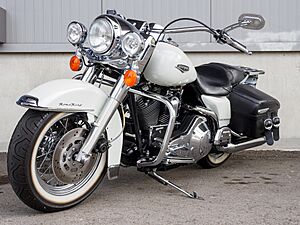
Milwaukee is home to the main offices of five large companies listed in the Fortune 500. These include Northwestern Mutual, Fiserv, and Harley-Davidson. Other important companies based here are Briggs & Stratton and Rockwell Automation.
Milwaukee has many financial service companies. Jobs in service and management are growing fastest. Health care makes up a big part of the city's jobs.
Brewing History
Milwaukee became famous for beer in the 1840s, thanks to German immigrants. By 1856, there were over two dozen breweries. For many years, Milwaukee was the world's top beer-producing city.
Once, four of the world's biggest breweries were in Milwaukee: Schlitz, Blatz, Pabst, and Miller. Today, only Miller remains a major brewery in the city. However, Milwaukee is seeing a rise in smaller, craft breweries.
The historic Miller Brewery is the oldest working major brewery in the United States. Other breweries like Milwaukee Brewing Company and Lakefront Brewery are also popular.
Other Industries
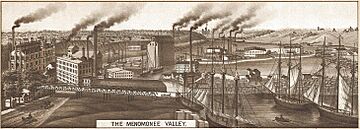
Milwaukee's location as a port city made it a center for trade. In the mid-1800s, Wisconsin became a major wheat producer. Railways were built to bring grain to Milwaukee's harbor.
The Menomonee Valley in Milwaukee has always been a hub for manufacturing, shipping, and other heavy industries. Early on, it was home to grain elevators, breweries, and tanneries. The Pfister & Vogel tannery became the largest in America.
In 1843, George and Jonathan Burnham opened a brickyard. They discovered a unique cream-colored brick from the local clay. Many city buildings were built with this brick, earning Milwaukee the nickname "Cream City." By 1881, the Burnham brickyard was the largest in the world.
The valley also became home to major industrial companies like Falk Corporation and Rockwell Automation.
Milwaukee's Culture
Milwaukee is known for its sailing, boating, and kayaking on Lake Michigan. It's also famous for its diverse food and cultural festivals. People often call Milwaukee the "City of Festivals." Many events happen at Henry Maier Festival Park by the lake during summer.
Museums to Explore

The Milwaukee Art Museum is a striking building, especially its wing designed by Santiago Calatrava. It has a moving sunscreen that looks like a bird's wing. The Grohmann Museum at the Milwaukee School of Engineering has a large art collection showing the history of human work.
The Milwaukee Public Museum is the city's main natural history and human history museum. It has exhibits on Africa, Europe, dinosaurs, and a "Streets of Old Milwaukee" display. It also has an IMAX theater.
Discovery World is Milwaukee's largest science museum. It has interactive exhibits, aquariums, and touch tanks. The S/V Dennis Sullivan Schooner Ship, docked at Discovery World, teaches about the Great Lakes. The Betty Brinn Children's Museum is great for younger kids, with hands-on exhibits.
The Pabst Mansion was built in 1892 by beer maker Frederick Pabst. It has been restored with old furniture to show what a Victorian mansion was like. The Harley-Davidson Museum, opened in 2008, celebrates Harley-Davidson motorcycles.
Performing Arts and Shows
Milwaukee has a lively performing arts scene. Groups like the Bel Canto Chorus and Florentine Opera perform choral and opera music. The Milwaukee Symphony Orchestra and Milwaukee Ballet offer classical performances.
The Milwaukee Repertory Theater and Milwaukee Public Theatre provide different kinds of plays. For kids, there's First Stage Children's Theater and the Milwaukee Youth Theatre. Many venues like The Rave/Eagles Ballroom and the Pabst Theater host concerts.
Public Art and Statues
Milwaukee has about 75 sculptures that honor the city's history and important people. Some famous monuments include:
- The Calling (a sculpture made of I-beams)
- Abraham Lincoln
- Bronze Fonz (a statue of the character from Happy Days)
- Martin Luther King Jr.
Milwaukee also has many murals. Black Cat Alley is a popular spot for street art on the East Side. Another area with street art is in the Walker's Point neighborhood.
Festivals and Fun Events
The city hosts Summerfest every year, a huge music festival by the lake. It was listed in the Guinness Book of World Records as the world's largest music festival. In 2017, over 830,000 people attended.
Milwaukee also has many ethnic festivals throughout the summer. These celebrate the city's diverse history.
- June: PrideFest (LGBTQ+ community) and Polish Fest.
- July: French (Bastille Days), Greek, Italian (Festa Italiana), and German (German Fest) festivals.
- August-September: African, Arab, Irish (Irish Fest), Mexican, and American Indian events.
Food in Milwaukee
Milwaukee's food scene includes many different ethnic cuisines. You can find German, Italian, Hmong, Serbian, Polish, Mexican, and Indian food, among others.
During summer, many ethnic festivals like Irish Fest and Festa Italiana celebrate different types of food.
Music Scene
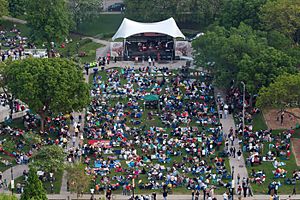
Milwaukee has a long history of music. Early famous musicians from the area include guitarist Les Paul and pianist Liberace. Hal Leonard Corporation, one of the world's largest music publishers, is based in Milwaukee.
Milwaukee is known for its rock, hip hop, jazz, soul, blues, and punk music. The biggest music event is Summerfest. It features hundreds of live music acts on many stages over 11 days.
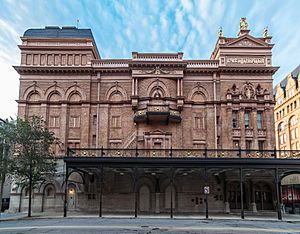
Other venues like the Pabst Theater and Riverside Theater host international acts. "Jazz in the Park" is a popular weekly jazz show held at Cathedral Square Park in the summer.
Sports in Milwaukee
Milwaukee has two major professional sports teams:
- The Milwaukee Brewers play Baseball in MLB at American Family Field.
- The Milwaukee Bucks play Basketball in the NBA at Fiserv Forum.
The city also has other sports teams:
- Milwaukee Admirals (Ice Hockey)
- Milwaukee Wave (Indoor Soccer)
- Milwaukee Milkmen (Baseball)
- USL Milwaukee (Soccer)
Milwaukee was once home to the NFL's Milwaukee Badgers. Today, the city is considered a second home for the Green Bay Packers football team.
Parks and Outdoor Fun
Milwaukee is known for its great park system, managed by Milwaukee County. The "Grand Necklace of Parks" was designed by famous landscape architect Frederick Law Olmsted. It includes Lake Park and Washington Park. Milwaukee County Parks offer places for sunbathing, picnics, and ice skating. The city has over 140 parks covering more than 15,000 acres.
The Milwaukee Riverwalk is a path along the Milwaukee River with art, cafes, and restaurants. It connects different parts of the city. It also links to the Hank Aaron State Trail, a path for walking and biking. Lakeshore State Park is a park on the shores of Lake Michigan. It's the only urban state park in Wisconsin.
Nature Centers
Milwaukee's parks have several nature centers. The Mitchell Park Horticultural Conservatory has three unique glass domes. These domes cover 45,000 square feet of display area. They include a Tropical Dome, an Arid Dome, and a Show Dome that hosts seasonal exhibits.
The Urban Ecology Center offers programs for all ages at its three locations. The Wisconsin Department of Natural Resources also runs a nature center at Havenwoods State Forest.
Local Markets
The Milwaukee Public Market, in the Third Ward, is an indoor market. It sells fresh produce, seafood, meats, and flowers from local businesses. It opened in 2005.
Milwaukee County Farmers Markets are held seasonally. They sell fresh produce, meats, and handmade items. You can find them at many locations around the city.
City Government and How it Works
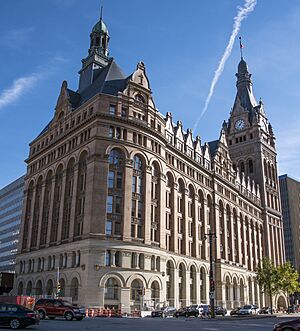
Milwaukee has a mayor-council government. The mayor leads the city, and the Common Council makes laws and controls the city's money. The Common Council has 15 members, one from each district.
Milwaukee has a history of mayors serving for a long time. For example, from 1948 to 2021, the city had only four elected mayors.
Milwaukee residents also elect representatives to the Milwaukee County Board of Supervisors and a Milwaukee County Executive.
At the national level, Milwaukee usually votes for the Democratic Party. Many of the state lawmakers representing Milwaukee are also Democrats.
Education in Milwaukee
In Milwaukee, about 89% of adults aged 25 and over have a high school diploma. About 32% have a bachelor's degree or higher.
Schools for Kids
Milwaukee Public Schools (MPS) is the largest school district in Wisconsin. It serves almost all of the city of Milwaukee. MPS operates many schools, including 18 high schools. Many MPS schools are "magnet schools," which means they focus on special areas like academics or the arts.
Milwaukee also has many private and religious high schools, middle schools, and elementary schools. In 1990, Milwaukee was the first city in the U.S. to offer a school voucher program.
Colleges and Universities
The University of Wisconsin–Milwaukee is a large public research university. Marquette University is a private Jesuit university near downtown. It is the largest private college in Wisconsin.
Other colleges include the Medical College of Wisconsin, Milwaukee Institute of Art and Design, and Milwaukee School of Engineering. The Milwaukee Area Technical College offers technical and job training. Women's colleges like Alverno College and Mount Mary University are also in the city.
Media and News
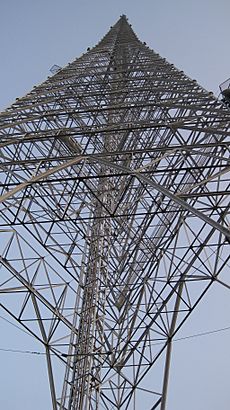
Milwaukee's main daily newspaper is the Milwaukee Journal Sentinel. The city also has free alternative publications like Shepherd Express. Other local magazines and online news sites include Milwaukee Magazine and Urban Milwaukee.
Milwaukee has many TV stations for major networks like NBC, Fox, ABC, CBS, and The CW. There are also Spanish-language channels and public broadcasting stations. Many radio stations serve Milwaukee and the surrounding area.
City Services and Transportation
Health Care
Milwaukee has several health care systems. The Milwaukee Regional Medical Complex includes Children's Hospital of Wisconsin, Froedtert Hospital, and the Medical College of Wisconsin. Other major health systems include Aurora Health Care and Wheaton Franciscan Healthcare. The Medical College of Wisconsin is one of only two medical schools in the state.
Getting Around Milwaukee
Most people in Milwaukee drive alone to work. However, many also carpool, use public transportation, or walk.
Milwaukee has two airports. Milwaukee Mitchell International Airport handles commercial flights. It is the largest airport in Wisconsin. It offers flights to many cities. The airport is also connected to downtown Milwaukee and Chicago by train.
Trains and Buses
Milwaukee's main train station is Milwaukee Intermodal Station. It was updated in 2007. Amtrak's Hiawatha train runs between Milwaukee and Chicago several times a day. The Empire Builder train connects Milwaukee to cities like Portland and Seattle.
Many bus companies also offer service to Milwaukee. The Milwaukee County Transit System provides bus services within Milwaukee County.
A modern streetcar system called The Hop connects downtown Milwaukee with other areas. It started running in 2018 and is a free way to get around.
Highways
Three major Interstate highways meet in Milwaukee: I-94, I-43, and Interstate 41. These highways help people travel across the city and to other parts of Wisconsin and beyond.
Biking in the City

As of 2022, Milwaukee has about 195 miles (314 km) of bike lanes and trails. The city plans to add even more protected bike lanes by 2026.
Milwaukee has been recognized as a bike-friendly city. The Bicycle Federation of Wisconsin holds an annual Bike to Work Week. The city has also installed many bike racks.
In 2014, Milwaukee launched Bublr Bikes, a bicycle sharing system. You can rent bikes from over 100 stations in the city and nearby towns.
Water Transportation
Milwaukee's main port, the Port of Milwaukee, handles millions of tons of cargo each year. It's also a stop for ferries and cruise ships on Lake Michigan. The Lake Express ferry offers service from Milwaukee to Muskegon, Michigan. McKinley Marina is the city's only public marina.
City Development
Milwaukee has seen many new development projects. The Northwestern Mutual Tower and Commons is the second tallest building in the city.
The Fiserv Forum is a new arena that opened in 2018. It's home to the Milwaukee Bucks basketball team and the Marquette Golden Eagles. The arena is part of a larger "live block" area with shops and homes.
Notable People
Sister Cities
Milwaukee has sister cities around the world. These partnerships help build friendships and understanding between different cultures.
 Abuja, Nigeria
Abuja, Nigeria Bomet, Kenya
Bomet, Kenya Daegu, South Korea
Daegu, South Korea Galway, Ireland
Galway, Ireland Irpin, Ukraine
Irpin, Ukraine Kragujevac, Serbia
Kragujevac, Serbia Medan, Indonesia
Medan, Indonesia Tarime District, Tanzania
Tarime District, Tanzania Zadar, Croatia
Zadar, Croatia
Friendship Cities
 Ningbo, China
Ningbo, China
See also
 In Spanish: Milwaukee para niños
In Spanish: Milwaukee para niños


